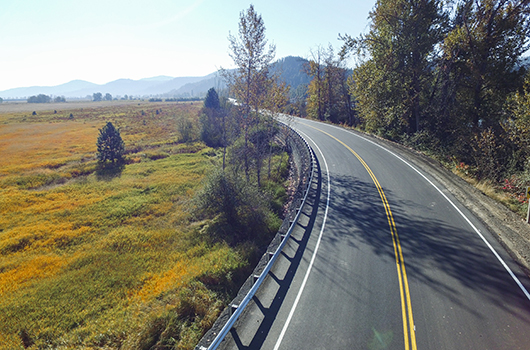Earlier today State Highway 3 north of St. Maries reopened with wider, safe shoulders. Traffic had been detoured to Goosehaven Road since work began in April.
Construction widened the highway 11 feet to the east, making room for 11-foot travel lanes and 3-foot shoulders. Guardrail was also added along the east side.
“The people that drive on this road every day had to drive on a really narrow road with no shoulders,” said Phil Lampert, Benewah County Commissioner. “This project makes it safer for everyone in the community and those who visit.”
Projects previously proposed to widen the highway had stalled due to environmental challenges and funding restraints.
“When we sat down with county commissioners three years ago, we heard that the desire for this project had only grown over the years,” said Bill Moad, the Idaho Transportation Board Chair. “After that meeting, we decided to use some of our own state funding to get design started.”
With new funding allocated by the board, design began in April 2020. Typically projects are developed through a seven-year process, but with local stakeholders willing to provide a detour for highway traffic, the project was expedited.
“That was a game changer,” said Jim Thompson, the board member for North Idaho. “There was no way to make these changes and accommodate traffic. Offering a detour showed how invested they were in the project, so we prioritized it.”
The three-mile section of highway cuts through wetlands, complicating any expansion effort. Traditionally, highways are expanded by importing embankment material and building the base outwards, but SH-3 was built on soft soils. Extra weight would collapse the soft soils and cause settlement problems for the highway; expanding outwards would also affect nearby wetlands that would trigger mitigation processes with other agencies. To get the safety improvements built sooner, the team wanted to find a way to avoid enlarging the highway past state property.
“We looked at a few options and using geofoam for the fill inside a wall system gave us an economical, lightweight solution,” said Erica Aamodt, ITD project manager for construction. “Since it can be stacked in blocks on top of each other, the foam would allow for a wider roadway without having to go outside of state-owned land.”
While geofoam has been used for other ITD projects—namely for the Topaz Bridge on U.S. Highway 30 near McCammon—this project uses more of it and over a curving length of three miles. The project was bid for $12.7 million, and work began in April, with contractor Knife River planning to build the project in one season—rather than two—thanks to the availability of a detour.
“Partnership is what ultimately made this project happen,” Aamodt said. “We knew this project would be tough to deliver and inconvenient for drivers and residents with the detour, but we all came together because we knew we could get it done in one season and it’d be worth it.”
Jack Buell, owner of Buell Trucking and a former county commissioner, has long advocated for the project and remembers taking Governor John Evans for a ride on the highway to convince him it needed to be widened.
“The best part is that the State of Idaho decided to fix it, and they fixed it,” Buell said.

